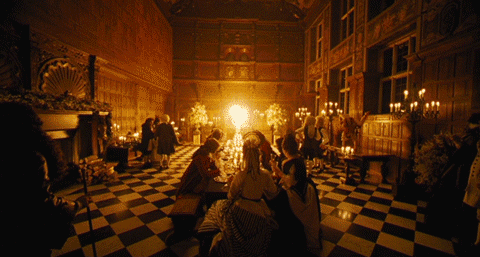The credits were only just starting to roll after The Favourite, a movie about political intrigue, manipulation, and same-sex love in Queen Anne’s court, and already I was reaching for my phone. I needed to find out whether the story was true—and, if it were, why hadn’t I ever known about it? I wasn’t alone with this question, as I heard other moviegoers around me ask their companions the same thing. I left the theatre with the belief that, in the span of two hours, I’d gone from knowing little about Queen Anne, who reigned over the British Empire during the eighteenth century and had a war named after her, to understanding her intimate life and fragile psychology. But in a film that was so clearly a satire of period dramas, in which characters mocked their own costumes, dances, and social etiquette, how much of the portrayal of Queen Anne was really true?
People often assume that movies about historical events and people actually teach us about the past. After all, “based on a true story” does mean based on a true story. But filmmakers’ interpretations of historical events often belie decades of scholarship, and this can make historians into serious buzzkills. I remember watching my mom’s eyes glaze over as I shared my thoughts on Lincoln, Steven Spielberg’s Academy Award for Best Picture–nominated film about the eponymous US president and the abolition of slavery. I was an earnest grad student at the time, and I immediately launched into the familiar tangent: “It was good, but . . . ”
Lately, though, I’ve come to realize historical accuracy comes in many forms. We often focus on the details of set designs and costumes, examining how closely they represent their intended time period. But good historical movies also offer unexpected perspectives of our collective past—and, often, those perspectives may be far more accurate to the spirit of the story than a strict adherence to the facts would be.
Judging the accuracy of historical movies is crucial because, whether professional historians like it or not, art shapes our understanding of the past. Generally speaking, movies represent the stories we tell about ourselves and, more often than not, the stories we want to tell about ourselves. This can result in misrepresenting, simplifying, or cherry-picking history so that it shows the stories movie studios think audiences will connect to.
As my own experience watching (and then googling) The Favourite reminded me, Queen Anne was a real person, as was Sarah Churchill, who in the movie is portrayed as the queen’s lover. The script takes plenty of creative liberties with their story. But it is a rare movie in that it highlights how the political machinations of powerful women in the 1700s happened behind the scenes, in private rooms and libraries. There are no so-called great men riding in to save the country, but there are also no great women. In telling the story of three complicated women, director Yorgos Lanthimos’s movie feels more contemporary and urgent because, quite frankly, many directors have overlooked women’s subtle yet significant roles in important political events. The Favourite is also very much about the times we live in: it dramatizes the absurdity of rabid partisanship, excessive wealth, political motivations, and a mercurial ruler who may be mentally unstable. The film’s success may be indicative of a shifting tide in the way we depict the past on the big screen—and in the way we imagine history as a whole.

Audiences and critics love historical dramas. Consider, for instance, some of the contenders at this year’s Academy Awards: The Favourite, Bohemian Rhapsody, Vice, BlacKkKlansman, and Green Book—the controversial winner of Best Picture. Of the Best Picture nominees since 2000, forty-seven of those strike me as “historical movies”—movies based on or inspired by true stories. Of those forty-seven nominees, eight won the top prize. In 2013, for instance, the Best Picture nominees included the history-based Captain Phillips, The Wolf of Wall Street, Dallas Buyers Club, Philomena, American Hustle, and 12 Years a Slave. Other genres, such as comedies and science fiction, rarely receive the same kind of validation.
Jonathan Gottschall, author of The Storytelling Animal: How Stories Make Us Human, says our proclivity for stories presented as “real” has a lot to do with a critical component of good storytelling: plausibility. “One thing I think is happening with this labelling ‘based on a true story,’ even if the basing is incredibly feeble, is it helps people get across that verisimilitude barrier. It helps establish that plausibility right off the bat,” said Gottschall. Research shows that claiming a movie is “based on a true story” increases the chance it will be well received—but only if the “typicality” of the story (meaning whether or not it matches our day-to-day lives) is low. In other words, it pays to say that Spike Lee’s BlacKkKlaansman, which won Best Adapted Screenplay, is based on a true story because audiences may need help believing that a black cop could have infiltrated the Ku Klux Klan to take down some members in the 1970s.

But however closely filmmakers hew to the term “true story,” the details that they choose to focus on, and those they choose to omit, inevitably skew the narrative—and, in some cases, they might obscure important perspectives in doing so. This year’s Best Picture winner, Green Book, has been accused of just that. Set in 1962, the movie is based on the true story of pianist Don Shirley and Frank Vallelonga, the Italian American driver hired to take Shirley on tour through the Midwest and Deep South. The film highlights the duo’s growing influence on each other, with Vallelonga increasingly exposed to, and appalled by, the racism that Shirley, who is African American, faces in many venues. Yet the film has been heavily criticized for its feel-good approach to a story of real racial violence in 1960s America. “Every suspicion you might entertain,” wrote film critic A. O. Scott in his New York Times review last fall, “that this will be a sentimental tale of prejudices overcome and common humanity affirmed; that its politics will be as gently middle-of-the-road as its humor; that it will invite a measure of self-congratulation about how far we, as a nation, have come—will be confirmed.”
The filmmakers have asserted that the screenplay, which was co-written by Vallelonga’s son, is biographical and draws on taped conversations with Shirley and Vallelonga. Yet some of the film’s tropes, which include scenes in which Vallelonga is compelled to intervene on Shirley’s behalf, have been criticized for reflecting a “white saviour” narrative that is so often woven through films depicting race relations in the US. Rather than focus on Shirley’s experience of trying to move and work across the South, the filmmakers zeroed in on Vallelonga and centred the story around his journey. Critics have also argued that the focus on the protagonists’ growing friendship masks a deeply troubling story of racial violence. (A family member of Shirley’s has criticized the script, calling it a “symphony of lies.”)
This kind of historical whitewashing is common. Consider the spate of critically acclaimed, Oscar-recognized movies about the Second World War, from 1957’s The Bridge on the River Kwai to 2017’s Dunkirk. The conflict is widely seen from the Allied perspective as the “good” war: a noble conflict that vanquished the world of evil and spread liberal, democratic ideals. And Hollywood’s typical depiction of the war reminds audiences that Americans, Brits, and sometimes Canadians and Australians endured unspeakable hardships but, in the end, were the good guys who triumphed over the Nazis.
We’ve yet, however, to see many mainstream movies that focus on the pivotal role Britain’s global empire played in propping up the tiny island kingdom during the First and Second World Wars or the racial segregation of American forces. Historians and pundits alike pointed out the trouble with this inaccuracy in Christopher Nolan’s Dunkirk. With rare exceptions, the troops are depicted as white. According to historical records, African and South Asian soldiers lined the beaches too. “They weren’t large in number,” British historian John Brioche wrote in an editorial for Slate, “maybe a few hundred among hundreds of thousands, but their appearance in the film would have provided a good reminder of how utterly central the role of the Indian Army was in the war.”
Their appearance might have also changed how the film was received. Coming on the heels of the Brexit vote, Dunkirk caused a stir in the United Kingdom when it was released in the summer of 2017. Pundits noted how the story of the evacuation of Dunkirk had been used by Brexiters as evidence of Britain’s self-reliance and tenacity. It’s part of what Guardian critic Steve Rose identifies as a broader embrace of nostalgia in British films in the Brexit era. It has become, he wrote, “a major component of British cinema, and very little of it seriously challenges or questions our ossified English self-image.”
In recent years, and thanks in large part to movements like #OscarsSoWhite, #MeToo, and #TimesUp, there’s been a greater push to create and embrace films that capture diverse experiences and feature diverse actors—making movies that are closer to the historical truth than the whitewashed versions so deeply embedded in popular culture are. Even before these movements started to flourish, there was a subtle but significant change in how the Oscars responded to movies about American slavery, a topic which has been given very little cinematic treatment given the mammoth influence it has had on the US as a whole. In 1939, Gone with the Wind, a movie that props up the belief that the slave-owning South and the Confederate army that fought to defend it was noble and benevolent, won the top prize, then called “outstanding production.” It took seventy-four years before another movie that depicted the institution, 12 Years a Slave, was celebrated with the same award. Directed by British filmmaker Steve McQueen, the film is an unapologetically visceral depiction of the commonplace brutality of slavery, as told through the story of Solomon Northup, a free man kidnapped and sold into slavery.
It is this dedication to showcasing the daily reality that makes 12 Years a Slave, in my opinion, one of the best historical films I’ve seen. Other favourites include The Witch (2015), an indie horror flick that captures the seventeenth-century Puritan obsession with witchcraft, and Jarhead (2005), which considers the psychological impact of the Gulf War on US Marines (in the words of one former Marine, “waiting is what [the movie] is about”). These are movies that leave the viewer with lasting images of how historically common, if horrific, something was, from the all-consuming fear Puritans had of both women’s sexuality and the wilderness to a young man visibly bored out of his mind in a desert that is foreign to him. One of the most horrifying images from 12 Years a Slave isn’t presented as climactic or shocking. It’s a lingering scene in which Northup hangs precariously from a noose on a Southern plantation. As day turns to dusk, the rest of the characters go about their day, save for one brave enslaved woman who brings him a quick sip of water. A man struggling on a noose becomes a part of the Southern landscape.
In a film genre that has traditionally focused on extraordinary moments of “greatness” and particularly the men whose deeds are said to have shaped the world, it’s encouraging to see storylines that follow the ordinary experiences of lesser-known characters in history. Not only are these stories more representative of history, they are also more likely to reflect our daily realities—and help us better connect with our past.


